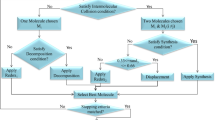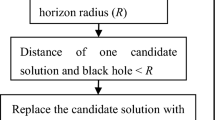Abstract
Uncertainty and complexity associated with the stock data make the exact determination of future prices impossible. Successful prediction of a stock future price requires an efficient prediction system. This paper proposes an artificial chemical reaction optimization based functional link network termed as ACFLN for stock market forecasting. The efficiency of the proposed model has been evaluated by forecasting five real stock market prices such as BSE, DJIA, NASDAQ, TAIEX and FTSE. Different experiments are conducted to evaluate the performance of the proposed model such as forecasting the stock price 1 day ahead, 1 week ahead, and 1 month ahead. Data is obtained for all the working days in a year and for each data the said experiments are conducted. From simulation studies, it is revealed that the proposed model achieves better forecasting accuracies over others.

















Similar content being viewed by others

References
Aboueldahab T, Fakhreldin Md (2011) Prediction of stock market indices using hybrid genetic algorithm/particle swarm optimization with perturbation term. In: International Conference on swarm intelligence (ICSI 2011), Cergy, 14–15 June
Adhikari R, Agrawal RK (2014) A combination of artificial neural network and random walk models for financial time series forecasting. Neural Comput Appl 24:1441–1449. https://doi.org/10.1007/s00521-013-1386-y
Alatas B (2011) ACROA: artificial chemical reaction optimization algorithm for global optimization. Expert Syst Appl 38:13170–13180
Alatas B (2012) A novel chemistry based metaheuristic optimization method for mining of classification rules. Expert Syst Appl 39:11080–11088
Al-Hmouz R, Pedrycz W, Balamash A (2015) Description and prediction of time series: A general framework of granular computing. Expert Syst Appl 42:4830–4839. https://doi.org/10.1016/j.eswa.2015.01.060
AlRashidi M, EI-Hawary M (2009) A survey of particle swarm optimization applications in electric power system. IEEE Trans Evol Comput 13(4):913–918
Ballings M et al (2015) Evaluating multiple classifiers for stock price direction prediction. Expert Syst Appl 42(20):7046–7056
Barak S, Modarres M (2015) Developing an approach to evaluate stocks by forecasting effective features with data mining methods. Expert Syst Appl 42:1325–1339. https://doi.org/10.1016/j.eswa.2014.09.026
Booth A, Gerding E, McGroarty F (2014) Automated trading with performance weighted random forests and seasonality. Expert Syst Appl 41:3651–3661. https://doi.org/10.1016/j.eswa.2013.12.009
Box GEP, Jenkins GM (1976) Time series analysis-forecasting and control. Holden-Day Inc., San Francisco
Chakravarty S, Dash PK (2012) A PSO based integrated functional link net and interval type-2 fuzzy logic system for predicting stock market indices. Appl Soft Comput 12:931–941
Dehuri S, Cho SB (2010a) Evolutionarily optimized features in functional link neural network for classification. Expert Syst Appl 37:4379–4391
Dehuri S, Cho SB (2010b) A hybrid genetic based functional link artificial neural network with a statistical comparison of classifiers over multiple datasets. Neural Comput Appl 19:317–328
Demsar J (2006) Statistical comparisons of classifiers over multiple data sets. J Mach Learn Res 7:1–30
Diebold FX, Mariano RS (1995) Comparing predictive accuracy. J Bus Econ Stat 13:253–263
Dorffner G (1996) Neural networks for time series processing. Neural Netw World 4/96:447–468
Dutta G, Jha P, Laha AK, Mohan N (2006) Artificial neural network models for forecasting stock price index in the bombay stock exchange. J Emerg Mark Finance 5:3
Fu-Yuan H (2008) Integration of an improved particle swarm optimization algorithm and fuzzy neural network for Shanghai stock market prediction. In: Workshop on power electronics and intelligent transportation system, IEEE, 978-07695-3342, pp 242–247
Ghazali R, Hussain AJ, Nawi NM, Mohamad B (2009) Nonstationary and stationary prediction of financial time series using dynamic ridge polynomial neural network. J Neurocomput 72:2359–2367
Göçken M, Özçalıcı M, Boru A, Dosdoğru AT (2016) Integrating metaheuristics and artificial neural networks for improved stock price prediction. Expert Syst Appl 44:320–331
Gurusen E, Kayakutlu G, Daim TU (2011) Using artificial neural network models in stock market index prediction. Expert Syst Appl 38:10389–10397
Harvey D, Leybourne S, Newbold P (1997) Testing the equality of prediction mean squared errors. Int J Forecast 13:281–291
Hassan MdR, Nath B (2005) Stock market forecasting using hidden Markov model: a new approach. In: Proc. IEEE international conference on intelligent systems design and applications. Warsaw, Poland. https://doi.org/10.1109/ISDA.2005.85
Karci A (2007) Theory of sapling growing up algorithm. Lecture notes in computer science 31:450–460
Karci A, Alatas B (2006) Thinking capability of sapling growing up algorithm iDEAL. Lecture notes in computer science, vol 4224. Springer, Berlin, pp 386–393
Karci A, Arslan A (2002) Uniform population in genetic algorithms IU. J Electr Electron 2(2):495–504
Khashei M, Bijari M (2010) An artificial neural network (p, d, q) model for time series forecasting. J Expert Syst Appl 37:479–489
Khashei M, Bijari M (2011) A novel hybridization of artificial neural networks and ARIMA models for time series forecasting. Appl Soft Comput 11(2):2664–2675
Kristjanpoller, Werner, Minutolo MC (2015) Gold price volatility: a forecasting approach using the artificial neural network–GARCH model. Expert Syst Appl 42(20):7245–7251
Kung V, Yu S (2008) Prediction of index futures returns and the analysis of financial spillovers—a comparison between GARCH and the grey theorem. Eur J Oper Res 186:1184–1200
Kuremoto T, Kimura S, Kobayashi K, Obayashi M(2014) Time series forecasting using a deep belief network with restricted Boltzmann machines. Neurocomputing 137(5):47–56
Lam AYS, Li VOK (2010a) Chemical-reaction-inspired metaheuristic for optimization. IEEE Trans Evol Comput 14(3):381–399
Lam AYS, Li VOK (2010b) Chemical reaction optimization for congnitive radio spectrum allocation. In: IEEE global telecommunications conference (GLOBECOM, 2010). Miami, FL, USA, pp 1–5. https://doi.org/10.1109/GLOCOM.2010.5684065
Lam AYS, Li VOK (2012) Chemical reaction optimization: a tutorial. Memet Comput 4:3–17. https://doi.org/10.1007/s12293-012-0075-1
Lam AYS, Xu J, Li VOK (2010) Chemical reaction optimization for population transition in peer-to-peer live streaming. In: The IEEE congress on evolutionary computation (CEC), Barcelona, 18–23 July 2010, pp 1–8
Lam AYS, Li VOK, Yu JJQ (2012) Real-coded chemical reaction optimization. IEEE Trans Evol Comput 16(3):339–353
Lee TT, Jeng JT (1998) The chebyshev polynomial based unified model neural networks for function approximations. IEEE Trans Syst Man Cybern B 28:925–935
Liu H-C, Lee Y-H, Lee M-C (2009) Forecasting china stock markets volatility via GARCH models under skewed-GED distribution. J Money Invest Bank 7:5–14
Majhi R, Panda G, Sahoo G (2009a) Development and performance evaluation of FLANN based model for forecasting of stock markets. Expert Syst Appl 36:6800–6808
Majhi R, Panda G, Majhi B, Sahoo G (2009b) Efficient prediction of stock market indices using adaptive bacterial foraging optimization (ABFO) and BFO based techniques. Expert Syst Appl 36:10097–10104
Majhi R, Majhi B, Panda G (2012) Development and performance evaluation of neural network classifiers for Indian internet shoppers. Expert Syst Appl 39:2112–2118
Mishra BB, Dehuri S (2007) Functional link artificial neural network for classification task in data mining. J Comput Sci 3:948–955
Mishra BB, Dehuri S, Panda G, Dash PK (2008) Fuzzy swarm net (FSN) for classification in data mining. CSI J Comput Sci Eng 5:1–8
Nayak SC, Misra BB, Behera HS (2013) Hybridizing chemical reaction optimization and artificial neural network for stock future index forecasting. In: International conference on emerging trends and applications in computer science, IEEE, Shillong, India. https://doi.org/10.1109/ICETACS.2013.6691409
Nayak J, Naik B, Behera HS (2015a) A novel chemical reaction optimization based higher order neural network (CRO-HONN) for nonlinear classification. Ain Shams Eng J. https://doi.org/10.1016/j.asej.2014.12.013
Nayak SC, Misra BB, Behera HS (2015b) Artificial chemical reaction optimization of neural networks for efficient prediction of stock market indices. Ain Shams Eng J
Nayak SC, Misra BB, Behera HS (2017a) Efficient financial time series prediction with evolutionary virtual data position exploration. Neural Comput Appl1–22. https://doi.org/10.1007/s00521-017-3061-1
Nayak SC, Misra BB, Behera HS (2017b) Artificial chemical reaction optimization based neural net for virtual data position exploration for efficient financial time series forecasting. Ain Shams Eng J
Oh KJ, Kim K-J (2002) Analyzing stock market tick data using piecewise non linear model. Expert Syst Appl 22:249–255
Pan B, Lam AYS, Li VOK (2011) Network coding optimization based on chemical reaction optimization. In: IEEE global telecommunications conference (GLOBECOM 2011). Kathmandu, Nepal, pp 1–5. https://doi.org/10.1109/GLOCOM.2011.6133697
Pao YH (1989) Adaptive pattern recognition and neural networks. Addison-Wesley, Reading
Pao YH, Takefuji Y (1992) Functional-link net computing: theory, system architecture, and functionalities. Computer 25:76–79
Patra JC, Bos AVD (2000) Modeling of an intelligent pressure sensor using functional link artificial neural networks, ISA Trans Elsevier 39:15–27
Patra JC, Panda G, Baliarsingh R (1994) Artificial neural network based nonlinearity estimation of pressure sensors. IEEE Trans Instrum Meas 43(6):874–881
Patra JC, Pal RN, Baliarsingh R, Panda G (1999a) Nonlinear channel equalization for QAM signal constellation using artificial neural networks. IEEE Trans Syst Man Cybern Part B Cybern 29(2):262–271
Patra JC, Pal RN, Chatterji BN, Panda G (1999d) Identification of nonlinear dynamic systems using functional link artificial neural networks. IEEE Trans Syst Man Cybern Part B Cybern 29(2):254–262
Patra JC, Kim W, Meher PK, Ang EL (2006) Financial prediction of major indices using computational efficient artificial neural networks. IJCNN, Vancouver, pp 2114–2120
Petrică A-C, Stancu S, Tindeche A (2016) Limitation of ARIMA models in financial and monetary economics. Theoret Appl Econ XXIII.4(609):19–42
Purwar S, Kar IN, Jha AN (2007) On-line system identification of complex systems using Chebyshev neural networks. Appl Soft Comput 7:364–372
Samui P (2014) Vector machine techniques for modeling of seismic liquification data. Ain Shams Eng J 5:355–360
Shin SY, Lee IH, Kim D, Zhang BT (2005) Multiobjective evolutionary optimization of DNA sequences for reliable DNA computing. IEEE Trans Evol Comput 9(2):143–158
Taieb SB, Bontempi G, Atiya AF, Sorjamaa A (2012) A review and comparison of strategies for multi-step ahead time series forecasting based on the NN5 forecasting competition. Expert Syst Appl 39:7067–7083
Truong TK, Li K, Xu Y (2013) Chemical reaction optimization with greedy strategy for the 0–1 knapsack problem. Appl Soft Comput 13:1774–1780
Wang Y (2003) Mining stock prices using fuzzy rough set system. Expert Syst Appl 24:13–23
Xu J, Lam AYS, Li VOK (2010) Chemical reaction optimization for grid scheduling problem. In: IEEE international conference on communications (ICC, 2010), Cape Town, South Africa, pp 1–5. https://doi.org/10.1109/ICC.2010.5502406
Xu J, Lam AYS, Li VOK (2011a) Chemical reaction optimization for task scheduling in grid computing. IEEE Trans Parallel Distrib Syst 22(10):1624–1631
Xu J, Lam AYS, Li VOK (2011b) Portfolio selection using chemical reaction optimization. World Acad Sci Eng Technol 5:402–407
Yang SS, Tseng CS (1996) An orthonormal neural network for function approximation. IEEE Trans Syst Man Cybern 26:779–784
Yu L, Chen H, Wang S, Lai KK (2009) Evolving least square support vector machines for stock market trend mining. IEEE Trans Evol Comput 13(1):87–102
Yu JJQ, Lam AYS, Li VOK (2011) Evolutionary artificial neural network based on chemical reaction optimization. In: IEEE congress on evolutionary computation (CEC, 2011), New Orleans, LA, USA, pp 2083–2090. https://doi.org/10.1109/CEC.2011.5949872
Zanaty EA (2012) Support vector machines (SVMs) versus multilayer perception (MLP) in data classification. Egypt Inf J 13:177–183
Zar JH (1999) More on dichotomous variables. Biostatistical analysis, 4th edn. Prentice Hall, Upper Saddle River, pp 516–565
Zhang GP (2003) Time series forecasting using a hybrid ARIMA and neural network model. Neurocomputing 50:159–175
Acknowledgements
The authors are very much thankful to the reviewers and the chief editor for their constructive suggestions which significantly facilitated the quality improvement of this article.
Author information
Authors and Affiliations
Corresponding author
Ethics declarations
Conflict of interest
The authors declare that they have no conflict of interest.
Rights and permissions
About this article
Cite this article
Nayak, S.C., Misra, B.B. & Behera, H.S. ACFLN: artificial chemical functional link network for prediction of stock market index. Evolving Systems 10, 567–592 (2019). https://doi.org/10.1007/s12530-018-9221-4
Received:
Accepted:
Published:
Issue Date:
DOI: https://doi.org/10.1007/s12530-018-9221-4



